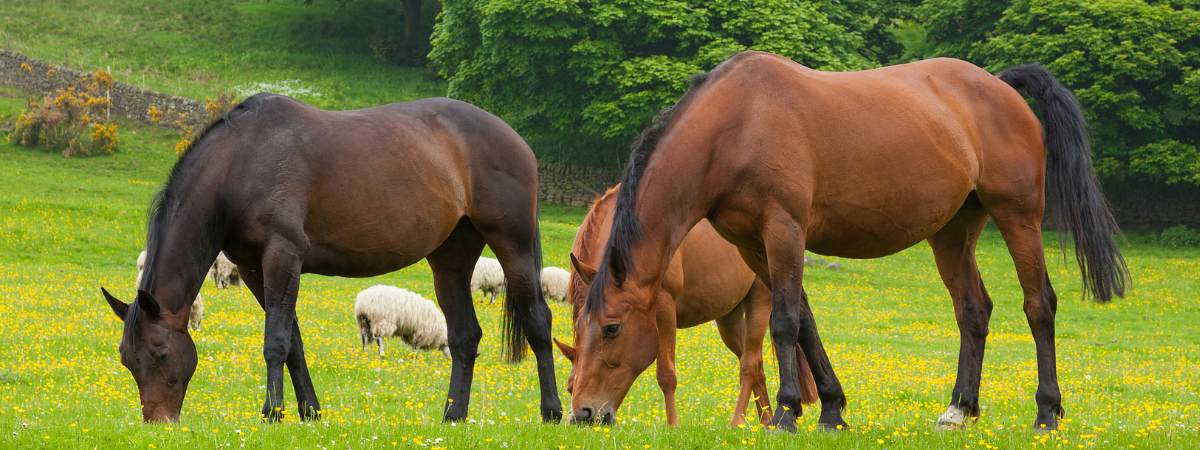Horses at grass are generally reflected as more cost effective and less labour intensive than those that are kept in. The horse can move more freely within the paddock and may have the opportunity to interact with other horse’s, the most natural way to be kept.
Why do we need to restrict grass intake?
The natural cycle of weight gain and loss of a wild horse depends on the quality and amount of forage available at that time of the year. During the spring and summer seasons, horses would generally gain weight in preparation for the winter months where grass is reduced with the colder weather. This natural cycle has been adapted by us, the owners, as our horses and ponies live in a domestic environment. This change means our horses are less likely to lose weight during the winter and may gain more weight as the year goes on. The risk of obesity within the UK equine community has become a constant factor for this very reason.
Read more: How to Maintain your Horse or Pony's Weight Through Spring
So how can we manage grass intake?
Finding a method to manage your horse’s grass intake will depend on what is most practical for the owner and suitable for the horse. This may become more difficult for horses kept in a livery yard that has limited resources on how you can manage your horse. Although moving to a more accommodating yard may seem challenging, what is best for your horse’s health is vital at the end of the day.
Are Grazing muzzles effective?
Grazing muzzles are fitted over the horse’s muzzle and will limit the amount of grass consumed through one or more holes. The muzzles can be used on horses that have access to grass but do not need the quantity available. This method will allow the horse to continue their regular turnout routine, freely moving in the fields and interacting with other horses, one of the added benefits of the muzzle.
Using a muzzle as part of a weight maintenance routine can be viewed differently between owners and the public if they have never used one before. The muzzle will not require the horse to be stabled alone and does not restrict the paddock area which some grazing methods will require. However, the key to introducing the muzzle to a new horse is to do it slowly, to provide a positive response to the new device. Ensuring the muzzle and the headcollar fit properly is also essential to ensure any escape artists cannot remove the muzzle. Dengie recommends that the muzzle can be used for up to 12 hours a day and then the horse should be removed from grazing when the muzzle is taken off


Strip grazing
Strip grazing is a well-known technique that is used not only in the equine world to manage grass intake, but also grass growth. The method requires strips of a field to be fenced off using stakes such as the Rutland Horse Polypost and moved accordingly to reduce the area of grazing available to your horse. The fence/tape such as the Rutland electro tape is gradually moved as the grass is grazed to allow greater access. Some owners may use a second fence to allow the grazed area to recover.
This method of grazing for weight loss requires regular monitoring, as the fence should be moved in accordance with the weight of the horse and the growth of the grass.
Track grazing systems
The popularity of grazing a horse on a track system has increased over recent years in the UK. The method is known differently amongst different people but generally involves fencing a track around the edge of a field, leaving the centre for haymaking or leaner horses. Enrichment resources can be placed around the track along with water and forage to encourage the horse to move around more often.
Although this method is becoming more popular, careful management is required like strip grazing. Managing the track size, hedgerow plantation and grass growth will ensure the correct adjustments are made to maintain effective weight management.
Reducing the available grass
Co-grazing your horses with other livestock such as sheep can reduce the amount of available grass. You can allow access to leaner horses first and then introduce the additional livestock to graze the area down.
Alternatively, some equine owners tend to mow paddocks and remove the clippings a couple of weeks prior to grazing, which would also reduce the amount of available grass.


Complete grass removal
If you want to completely take control over the grazing pattern of your horse, removing grass from the equation is the key. This is a particularly fixed method for horses who are prone to laminitis but can also be used temporarily during times when the grass is more abundant.
Areas that have a sand, woodchip or rubber base can be used for this management method. However, caution should be taken when sand is used, as an accumulation of sand in the gut could cause colic where forage is provided, and the sand is accidentally consumed. The bare paddock areas tend to be much smaller than a regular paddock and can reduce your horse's movement; this can be seen as a disadvantage to some. Although, the interaction with other horses may be increased and the availability of cleaner air outdoors can benefit individuals with respiratory issues.
Things to remember
- The grazing method you choose for one horse may not be suitable for another.
- Whichever method you decide to use needs to be closely monitored, and the behaviour, condition and fat score of your horse needs to be regularly checked.











